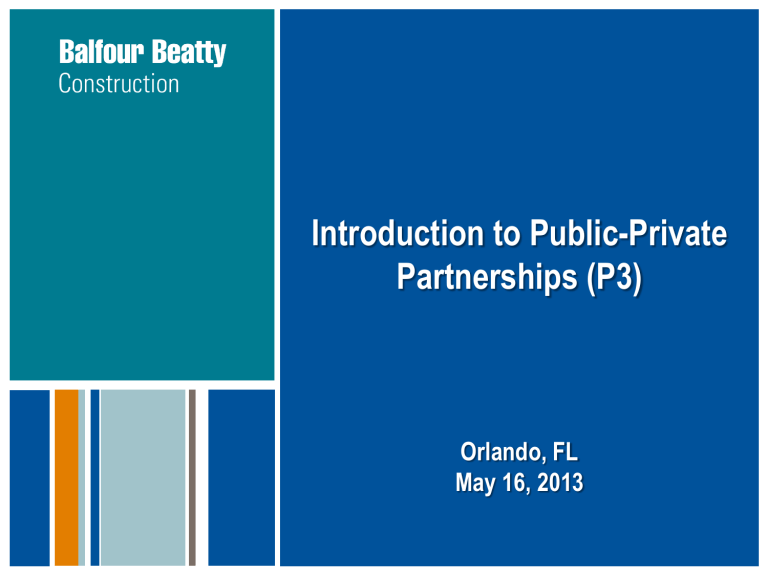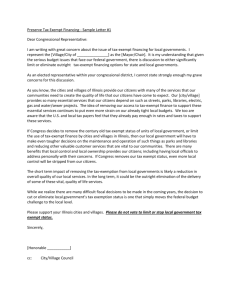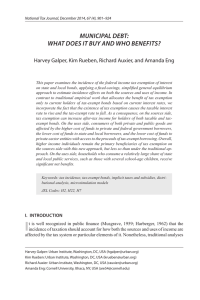KEN-PORTNOY-Introduction-to-P3-for-Clients-REVISED-05

Introduction to Public-Private
Partnerships (P3)
Orlando, FL
May 16, 2013
1
What We’ll Cover
Introduction to Public Private Partnerships (P3)
• The state of Infrastructure
• What P3 is (and isn’t)
• What makes P3 different in the US than in the UK or Canada?
• What is needed for a successful P3 project?
• How is P3 valued?
• Dispelling the myths of P3
2
State of our Infrastructure and its Economic Impact
• The ASCE’s “Failure to Act” (December 2012) paper states investment of $2.7 trillion is needed by 2020; likely funding available, $1.6 trillion.
• The Congressional Budget Office says combined federal, state and local spending for roads and bridges now amounts to only $160 billion.
• The investment gap between now and 2020 is $39 billion in airports, $16 billion in seaports and waterways, $846 billion in surface transportation, $107 billion in electricity, and $84 billion in drinking water and wastewater.
• “Job losses will mount annually, and by 2020 it is predicted that there will be 3.5 million fewer jobs throughout the country,” the paper said.
• “The expected impact for every household in the U.S. will be an average loss of more than $3,000 per year through 2020 in disposable personal income . . . due to job cutbacks and declining business productivity.”
3
Infrastructure Deficits by Sector
Roads
Bridges
Rail Transit
Aviation
Schools
Drinking Water
Waste Water
Levees/Flood
Solid Waste
Ports
Energy
Texas
D
B-
C+
C+
D-
D-
C-
D-
B+
C
B+
Florida
C
B
C
B-
D+
C
C
D+ n/a
C
D
North Carolina
D-
C-
C
D+
C-
B-
C+
D n/a n/a n/a
4
Population Growth Drives Demand
0% to -0.1%
1.1%
0.8%
0.8%
0.7%
1.6%
0.9%
1.4% 1.5%
1.4%
1.0%
1.3%
0.3%
0.1% to 0.5%% 0.6% to 1.0% >1%
2.2%
1.2%
0.7%
0.5%
0.8%
0.6%
0.3%
0.3%
0.2%
0.4%
0.1%
0.3%
0.4%
0.1%
0.2%
0.3%
0.0%
0.3%
0.0%
1.0%
1.0%
0.9%
0.4%
1.1%
1.1%
1.7%
0.6%
1.2%
0.0%
CT
0.1%
DE
1.0%
MD
0.8%
NH
0.2%
VT
-0.1%
MA
0.6%
RI
0.0%
NJ
0.3%
DC
2.1%
HI
1.0%
Source: U.S. Census Bureau
5
What states have P3 Legislation?
6
P3 Projects Around the Country
UCF Convocation Center Dallas Omni Convention Center Hotel
Washington State Dept. of Information FAU Innovation Village
7
What is P3?
Definition: A contractual agreement between a public agency and a private entity under which skills, assets, risks, and rewards are shared in the delivery of a service or facility.
• NCPPP identifies 18 different legal and financial P3 structures ( www.ncppp.org
) based on who owns, finances, designs, builds, operates, or maintains the project.
8
What P3 is NOT?
TANSTAAFL
• Equity or debt require a return on capital and of capital
• Identify revenue streams
• Target alternative funding sources
• Explore level of public support
9
What P3 is NOT?
“One size does not fit all”
Key to Success
Creating a P3 structure that meets the specific financial, legal, and political constraints of the client
10
What makes US P3 models different?
There is no “one” P3 Model or Template to Follow
• The US has an estimated 70,000 public entities
• Municipalities, school districts, universities, community colleges, courts, public agencies, and authorities
• Local statutes, financial constraints, politics
• Wide range of projects
• Income and non-income producing assets
• Horizontal and vertical construction
• No uniform P3 contracts
• The exception: Military Housing
• One client, the DOD
• One contract form
• Replicable over many projects (50 bases in 26 states)
11
What makes US P3 models different?
Taxable vs. Tax-Exempt
• IRC 103(a) - statutory provision excludes earned interest on municipal bonds from federal income tax
• IRC 501(c)3 - organized and operated exclusively for exempt purposes and none of its earnings may inure to any private shareholder or individual
• 63-20 Corporations - power to issue municipal bonds, treated as debt obligations funded on behalf of, but not an obligation of a political entity
• Public use and public ownership requirement
12
What makes US P3 models different?
Taxable vs. Tax-Exempt
Tax-exempt status can provide municipalities, public agencies, and not-for-profit institutions a 35% to 40% reduction in cost of occupancy
Developer
Use
Taxable vs. Tax-Exempt
Debt
Financing Structure
P3 – Private Equity Model P3 – Public/Tax-Exempt Model
Private Ownership and
Developer’s Equity at Risk
Public or Private
Taxable Only
Fee-Developer, Limited Risk
Public Only
Taxable or Tax-Exempt
Conventional Bank Debt
• Construction Loan
• Mezzanine/Permanent Debt
• Owner’s Equity
• Typically 10 year refinance
Municipal Bond Market
• Single Financing
• Flexible Payment Structures
• Up to 40-year term
• Higher fixed-costs
13
Case Study - Dallas Omni Hotel
• 1,001-room city-owned hotel provided necessary economic boost for underperforming 2.1 million SF convention center
• Financed by $480 million taxable hotel revenue bonds under the American
Reinvestment and Recovery Act’s Build
America Bonds saving the City over $3 million per year over 30 years
• Team included Matthews Southwest as developer, Balfour Beatty as design-builder,
First Southwest as financial advisor, and
Omni Hotels as operator
• Project delivered 3 months ahead of schedule, substantially under budget , and performing above pro-forma
14
What can P3 do for Public Entities?
Closing
Funding &
Timing Gaps
• Identify new revenue streams
• Housing, Parking, Retail
• Mixed Use, Economic Development
• Create new tax or fee revenue
• Hotel/Motel and Rental Car Tax
• User fees and surcharges
• TIF Districts
• Access alternative funding sources
• Government grants
• EB5, New Markets Tax Credits
• Monetize under-utilized assets
• Sale or Lease
• Operational savings can increase financing capacity
• Not subject to voter referendums or capital budget allocations
15
Case Study - Florida Atlantic University
• 1,216-bed apartment style on-campus student housing village by BB Capital Group
• FAU established a Direct Support Organization
(DSO) to be the nominal owner of the facility authorized to issue tax-exempt debt
• Waterfall : cash flow from existing student housing flows to new housing enhancing debt, then from new housing to FAU for any purpose
• Strong revenue projections allowed FAU to clear $12 million from the housing bond sale to support other on campus infrastructure .
• BB Capital invests through a junior debt piece of $3.4 million
16
What can P3 do for Public Entities?
Risk
Transfer
• Transfer risk to the party best able to control it
• Design risk
• Construction risk
• Schedule risk
• Operating risk
• Revenue risk
• Financing & interest rate risk
• Political risk
• Takes advantage of private sector efficiencies and innovations in construction, scheduling, and financing
• Provides efficiencies in long-term operations and maintenance (“life-cycle”)
• Presents opportunity to combine public and private uses in mixed-use developments to leverage economic development
17
How is a P3 Proposal Valued?
How do we know if a P3 is the best approach?
• Public Sector Comparator (PSC)
•
• The “benchmark” of standard public procurement
Costs of procurement and long-term operations
• Value for Money (VfM)
• Discount rate, “Time Value of Money” includes inflation, interest rates, and risk
• What is the value to the public-sector of each risk is transferred?
• Design and construction costs
• Private sector procurement costs
• Value of alternative financing
• Value full life-cycle costs (O&M)
“Up to 60% of P3 savings may come from risk transfer”
18
How is a P3 Proposal Valued
Value for Money (VfM)
19
What are the keys to success?
What is needed for a successful PPP
• An essential facility needed today
• A political champion, leader
• Statutory environment (competitive procurement process, transparency, etc.)
• Detailed contract (business plan with clear VfM)
• Existing or proposed revenue streams
• New tax, user fee revenue, or grants
• Lease agreement
• New revenue through economic development
• Stakeholder support
• Selection of “best value” partner and team
20
Case Study - WA Dept. of Information
• Delivered through a 63-20 Corp for the
State of Washington
• Lease/Leaseback 35-year term
• Allowed state to avoid substantial frontend costs
• Mission Critical facility
• LEED® Platinum, 480,000 SF, 6-story building
• $225 million total development budget
• Developer Wright Runstad provided a maximum lease price for the state
• First new building on state campus in over 2 decades
21
Frequently Asked Questions
Dispelling the Myths
• “I can borrow at lower rates than you can.”
• General obligation debt (G.O.), tax-exempt financing vs. conventional private debt and equity
• Small premium for accelerating delivery, reducing construction cost, and lowering interest rate risk
• “I will lose control of the project.”
• P3 is collaborative, transparent, and “open book”
• “Off-balance sheet is not off-credit.”
• Not considered “debt,” but a moral obligation
• “Private partners make excessive returns”
• Transparent, “open book” process
• Transfer of risk to the party best able to manage it
• Revenue sharing provisions
• Contract rebalancing provisions
• Alignment of interests
22
When should P3 be considered?
As Early as
Possible
• The P3 process begins with the “need” and the “concept”
• Identify and quantify the funding gap
• Explore solutions to bridge the gap
• The public sector may not be aware of all available funding and delivery options
• Staff may not have the expertise to deliver a
“once in a generation” facility
• Could overlook a more efficient financial, scheduling, and operational solution
23
What are Potential P3 Projects?
Education
• K-12 – schools, administration, sports
• Higher Education - administration, athletics, student unions, housing, healthcare, parking, laboratories, and multi-use economic development
Healthcare (Public and Non-Profit)
• Ambulatory care clinics
• Housing, MOB for staff physicians
• Parking, central plants
• Multi-use economic development
Justice
• Jails, detention centers
• Courthouses
Energy Retrofit
• Financed through savings
• Lighting, HVAC, building envelope, water, renewable energy, “net-zero”
Municipal
• Civic centers, city hall, administration
• Libraries, parking
• Police, fire, health, and public safety
• Mission Critical facilities
Public Assembly
• Convention and conference centers
• Performing arts
• Arenas and stadiums
• Headquarter hotels
24
So What?
P3 and the Delivery of your Essential
Facilities
• Close a Funding Gap
• Close a Timing Gap
• Transfer Risk
• Provide for Future Life-Cycle Costs
“You can’t solve a facilities problem with just a construction solution”
25
How to Increase Infrastructure Investment?
• Remove legislative impediments to P3 and other forms of alternative delivery that will provide greater speed to market and greater risk transfer
• Assemble top-flight P3 government advisory resources from the private sector
(e.g., Partnerships BC, Infrastructure Ontario)
• Prioritize projects that have the best P3 potential and issue RFP’s with people authorized to drive the procurement
• Require demonstration that P3 has been explored before traditional appropriation or bond financing is requested
• Create/fund infrastructure banks to backstop critical projects
• Increase federal loan/backstop programs and modify them to include P3 (i.e.,
MAP-21)
26
Q & A
27








